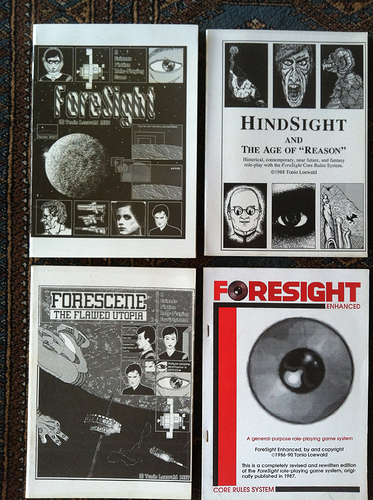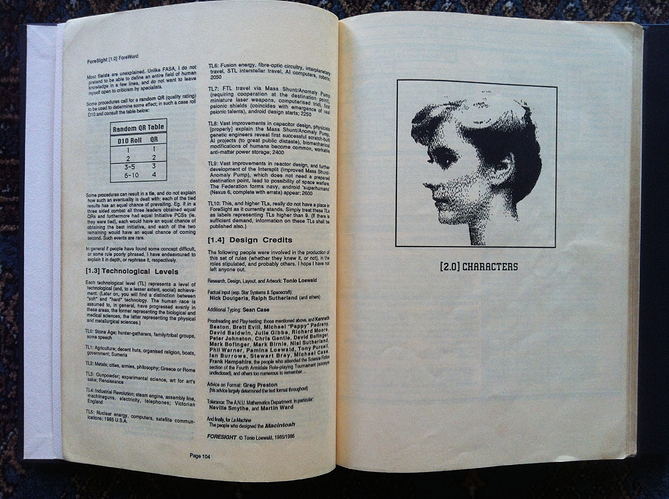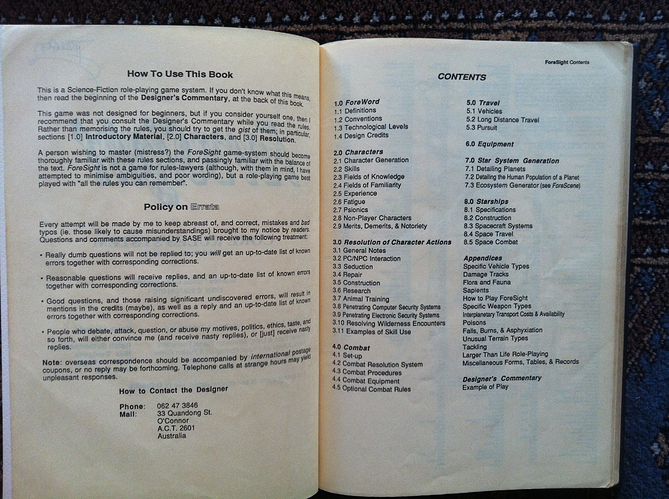Chapter 3: Resolution system
Section 3.0 of ForeSight laid out a cleaned up and generalised version of the Ease Factor:Quality Rating resolution system out of SPI’s James Bond 007. The major change was that where the JB007 version was table-driven, ForeSight’s version was worked by comparing the die roll to various factions of the success chance. Playing ForeSight made me learn to do one-digit by two-digit multiplications, and to divide by two and five.
There is a summary of the resolution system, in large type, suitable to be photocopied and distributed to players, on the back of the chapter flyleaf. More than half the page is taken up by a division table.
The basic story of the EF:QR system is that a character has a PCS representing his ability in a skill. The skill has a Base Ease Factor (always 5 in JB007, in ForeSight they varied somewhat from skill to skill, and often included a variable for the character’s familiarity eg. with the gravity or the environment). Modifiers for circumstance and task difficulty are applied to the Base Ease Factor to yield a modified Ease Factor. Then you multiply the character’s PCS by the task’s EF to get a success chance. Roll d100. A result over Success Chance is a failure (in ForeSight, “Quality rating 7”) and maybe a botch (in ForeSight, “QR10”). A roll of SC or under is a success. If it is under 1/10 of SC (a tabulated value in JB007) it is a Quality Rating 1 (ideal success). If it is under 1/5 of SC but not a QR1 it is a QR2. If it is under 1/2 of SC but not a QR1 or QR2 it is a Quality Rating 3. If it is SC or under but not a QR1, QR2, or QR3, it is a QR4 (bare success). Exceptions: 00 is never better than QR7, even if SC > 99.; 99 is never better than QR4, even if SC>199.
Each quality rating is associated with a “yield percentage” (for use when the amount achieved is important) and a “time to complete” (for use when speed is of the essence). Also, the scale of QRs is appropriate for them to be used as BEFs for opposing tasks, or as a basis for (negative) EFMs for tasks building on the task achieved.
When I first encountered this system I thought it over-elaborate, but I came to appreciate it and the smooth and consistent way in which it handled degree of success in all tasks I grew very fond of it. It is flexible and powerful in proportion to its complexity, and not too complex for a universal task resolution procedure.
§3.1 set a scale for freehand task difficulty modifiers.
§3.2 was a set of rules for using the Charisma and Confidence skills to persuade an NPC to do a favour, based on the NPCs initial demeanour.
§3.3 was a four-step procedure for a PC to seduce an NPC, based on the five-step procedure in James Bond 007/
§3.4 was the repair rules, covering surgical repair of injuries inter alia. The size, complexity, and degree of damage to an object combined to give a time and ease factor modifier for the repair. Quality of equipment and QR of diagnosis modified the EF. The rules covered partial repair.
§3.5 was abstract design and construction rules. §3.6 was research rules. §3.7 was animal training, a four-step task. §3.8 was a four-stage task for penetrating computer systems. § 3.9 was a four-stage task for penetrating electronic security systems.
§3.10 was a neat little system (half a column) using opposing Stealth and Scan rolls (based on Environment Familiarity) to resolve the conditions of contact (range, surprise, initiate) of opposing parties that were travelling, patrolling, or setting ambush in arbitrary terrain.
§3.11 covered teamwork, allowing three modes: division of labour; “many hands make light work”, and “a second opinion”.
§3.12, the conclusion of the Resolution chapter, was a page and a half of guidelines and examples for using skills and setting task difficulty modifiers.
Chapter 4: Combat
The combat system in ForeSight was, I believe, based on that in SPI’s Commando. It was played on a hex-grid in turns, with each hex representing about a metre, and each turn about 3 seconds. Each character got to do several things in each turn, the number depending on his or her Speed. Speed was based on Agility and Perception, and was modified for fatigue, injury, encumbrance, and stiff or heavy armour on the limbs. The possible actions were listed, their effects and options (eg. hexes where you might end up, facings that you might end up in, etc.) very clearly illustrated with diagrams. The turn sequence was unambiguous and clearly set out.
I loved the ForeSight first edition combat system, but most players found it tricky. You had to be careful about setting up the first turn of a combat (though a few simple rules allowing characters to take opportunity actions to defend themselves before their pulse began in the first turn of a combat would have fixed that). And there were important tactics in the use of the game system, so that a good player with an inferior character could (fairly reliably) defeat a bad player with a superior character. I thought that the solution to this problem was to learn to play the game, but many players did not want to make tactical decision other than on the sort of level and in the sort of terms that their characters would.
In a long-running HindSight game , I had a character who on paper had less than 2% chance to win a fight against any of the other PCs, but who defeated more NPCs than all the others (except the magician) put together. There is a strong case to be made that the combat system in ForeSight was more of an included game than a suitable resolution procedure for an RPG.
§4.1 was combat setup, including a procedure for finding cover in the first seconds of combat, which depended on a Scan roll by the character and the terrain value of the environment.
§4.2 was the sequence of actions for the combat system, the rules for character Speed, the different actions which could be taken with action ponts or by devoting a whole pulse to them.
$4.3 was combat task resolution, including the parry and dodge rules, the armour and injury rules, the rules for getting stunned and recovering from stun, and the standard ease factor modifiers for ranged and mêlée combat.
§4.4 was combat equipment.
There a large (full-page) table of weapons with their performance modifiers, ammo, rate of fire, damage class, ranges (using the same system as in James Bond 007), concealability ratings, draw and reload times, jam ranges, weight, tech level, and cost, and a flag to note which skill they were used with. The same table was used for ranged and mêlée weapons, so that every firearm had full stats for use as a mêlée weapon. The arrangement of the weapons in that table had no pattern that I could see, which was annoying. There weren’t many weapons at each tech level (at ForeSight TL8 you had the protein disruptor (from Universe, I think), the TD (“target-designating”) laspistol and lasrifle, and the DEXAX needler and DEXAX needle rifle (the pistol from Vance’s Planet of Adventure, the rifle by analogy). This shortage was greatly eased by a system in an appendix which allowed one to apply modifiers to base weapons, providing stats for heavier and lighter calibres, shorter formats, target-shooting models etc.
The descriptions of the weapons in §4.4 were minimal. But not I think sub-minimal.
The table of armour was much smaller, but the system was that you bought armour separately for the head, chest, abdomen, each arm, and each leg, so there was scope for customisation. The 21 types or armour in the table included at least to two types (one rigid and one flexible) at each TL from 0 to 9. Each type of armour had separate ratings for its protectiveness against three damage types (mêlée, impact, and beam), a modifier to character speed for each limb dressed in it, a concealability rating, a vision modifier for a helmet made of it (or a usual matching quality of helmet), a base mass, a tech level, and a base cost.
There was a column on exoskeletons, including a load-bearing (“augmented”) and a combat-optimised (“combat”) exoskeleton at each tech level from 7 to 9, plus freaky things called “power roos” at TLs 8 and 9. The section concluded with a column of stats and rules for environment suits: breathing masks, SCUBA, NBC suits, thermal suits, and vacc suits.
§4.5 “Optional Combat Rules” includes stats and rules and special actions for hand grenades, alternative rules for more realistic damage and parrying, minimum strength for weapon use, and equipment listings for high-tech mêlée combat weapons called “battle harness” (from Universe, I think. It concludes with special actions and rules for tripping, knockout blows, entangling attacks, grabs, disarms, restrains (wrestling), knockback attacks, throws (as in Judo), and strangle attacks.
To be continued





